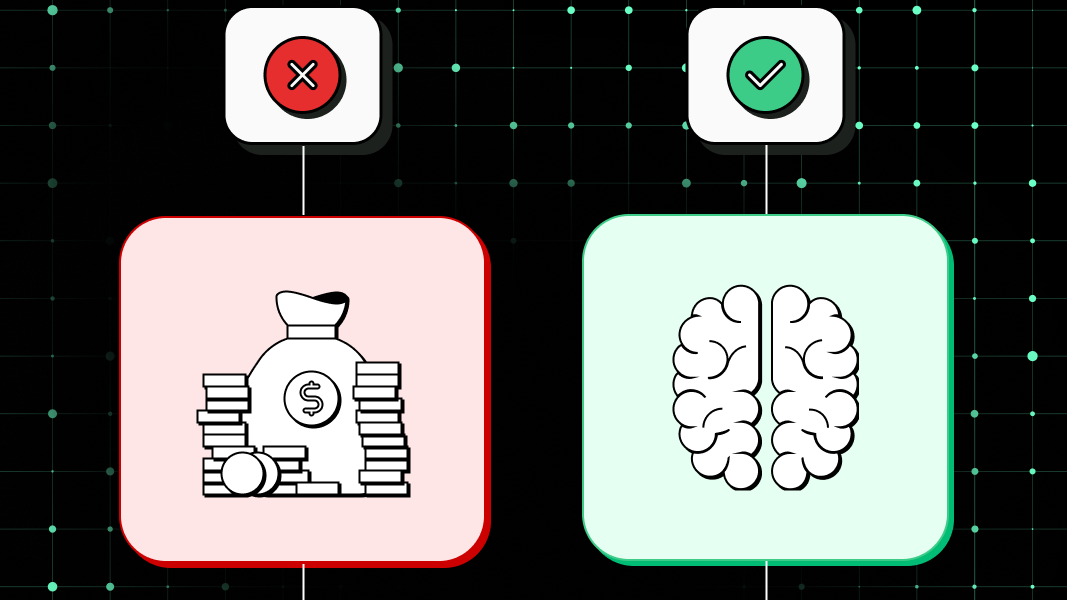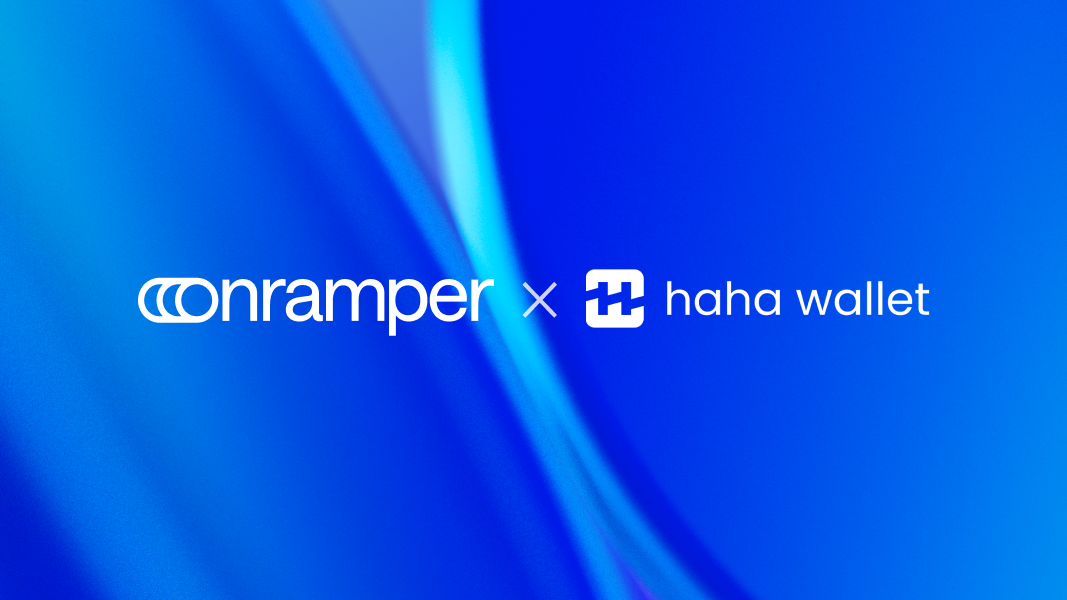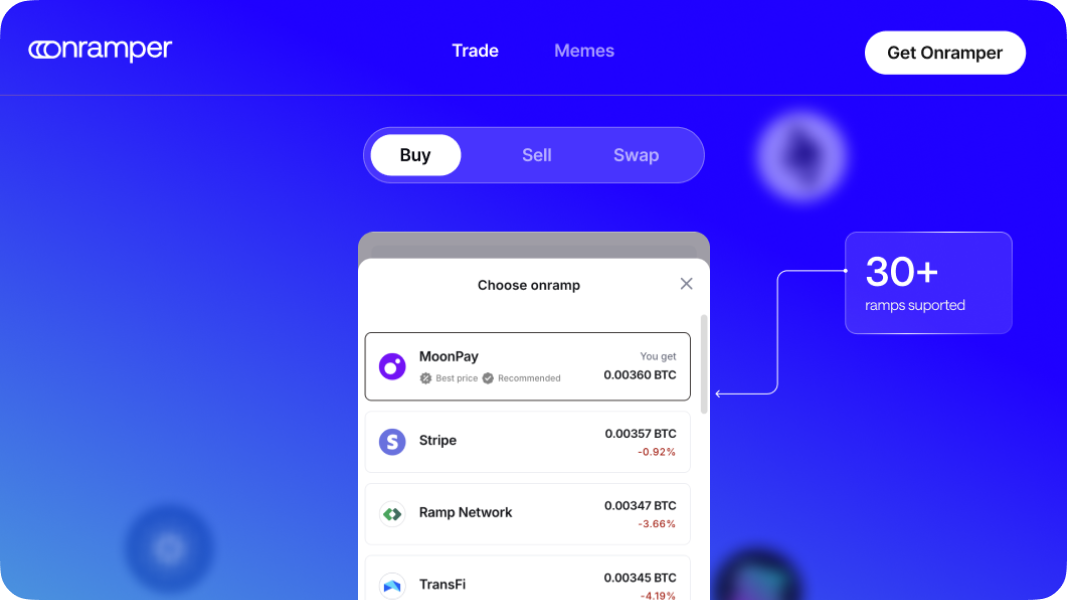Blog
Fee-based onramp routing is costing you business
The most popular method for connecting users to onramps is deeply flawed — for a number of reasons. Here's why you should be considering alternative solutions.

My user has multiple onramps available. I should automatically point them towards the one that offers the lowest fees.
On the surface, this is a great decision. It makes perfect sense to want to provide your users with the lowest fees, as it results in more crypto received.
In practice, though? The transactions fail the majority of the time. And, even when they do succeed, the fees aren’t what you think.
What’s up with onramp fees?
The top providers offer some very attractive percentages when it comes to their fees. Dig a little deeper, however, and you’ll find out that these figures only refer to the onramp’s cut.
In other words, there are other costs involved. Our recent report identified the culprits as conversion rates, bid-ask spreads and network fees.
These aren’t negligible, either: when we conducted a $200 USD → BTC swap on six different onramps, the crypto received varied by over 10% from solution to solution.
In short: price quotes are getting spoofed across the board. If lowering fees is your utmost priority, benchmark based on the crypto your users receive.
The critical flaw in fee-based routing
Let’s assume that fee-based routing does work as intended, and that it consistently matches your users with the cheapest onramp.
There’s still an excellent chance that this onramp isn’t actually able to complete the transaction. Owing to a range of factors, a given onramp is a poor fit for the majority of users. For instance, some solutions might be optimized only to cater to a limited European audience, while others may only be appropriate for a handful of Asian countries.
Even then, that’s a gross oversimplification. Transaction success hinges on over 70 factors, ranging from user location to their desired currency pair. With so much happening under the hood, transaction failure is basically a coin flip away when you don’t optimize your routing practices.
A strategy based on finding the lowest fees alone fails to take these factors into account — which is why you should consider the alternatives.
Which onramp routing strategy is best?
No method reigns supreme, though a handful stand out. In all cases, the more onramps available, the more effective your routing efforts can be:
- It means more options to point your users towards
- It means more sources to learn from and improve on the data collected
We advise that players in this space aim to aggregate at least 10-15 onramps. That way, you’ll have ample global coverage and plenty of fallback options should a single onramp go offline.
With that in mind, here are our top picks, based on over two years of onramping insights.
Success-based routing
This logic does what it says on the tin: it routes your users towards the onramp most likely to ensure transaction success.
Our engine does so by learning from previous transactions and matching users with onramps that have been successful for historical users matching their profile.
Return-user routing
Success-based routing is fantastic out of the box, but you’ll soon want to stack more precise routing rules on top of it to really push for high success rates.
Return-user routing doesn’t just make an informed decision based on industry-wide data. It actually recognizes the user if they’ve completed a transaction previously, and recommends the onramp they used.
Low-KYC routing
Know Your Customer regulations are in place for good reason — but the flows designed to identify users can be cumbersome and, often, needlessly complex.
With low-KYC routing, users are matched with the route that requires as little verification as possible for their desired transaction. This method is particularly effective, as KYC complications majorly impact success rates.
Route smarter with Onramper
Since our inception, we’ve made it our mission to create an onramping machine living up to the promise of the crypto revolution. That means a consistent fiat → crypto experience for all users, regardless of their location.
Time and again, success-based routing (paired with other logic) delivers phenomenal results for our clients and their users. Whether you’re just starting out and prefer a fully managed solution, or you’ve already got an in-house aggregator and want to expand your offering, our suite has you covered.
→ Download our latest success rate case study
Other articles

Wello Joins Onramper’s Network to Expand Crypto Onboarding in Nigeria
Collaboration strengthens Onramper’s Nigerian payment rails for all partners
December 19, 2025 – Onramper, the world’s leading fiat-to-crypto onramp aggregator, announced that it has integrated Wello, a global fiat on- and off-ramp provider, to increase crypto accessibility in Nigeria. By integrating with Onramper, Wello’s localized payment rails will reach a wider audience, beginning with Nigeria and expanding across Asia. This partnership is part of the broader plan to bring stablecoin-powered payments to local markets around the world.
Nigeria remains one of the most active crypto markets globally, but ensuring reliable and high-performing fiat-to-crypto rails in the country remains a challenge. By incorporating Wello’s localized infrastructure, Onramper strengthens its presence in the region and delivers smoother, more successful conversion paths for every partner operating in Nigeria.
“Wello will strengthen the global coverage of our aggregation engine,” said Thijs Maas, CEO of Onramper. “Its dependable and deeply localized infrastructure gives our partners, and their users, the onboarding experience they expect, in Africa and beyond.”
Wello brings strong regional expertise across Africa and the Middle East, with payment rails designed for fast-growing, high-adoption crypto markets. Its localized approach reduces failed transactions and improves uptime for Nigerian users.
Onramper continues to lead the onramp aggregation space, connecting more than 30 global fiat gateways and supporting over 2,000 digital assets. All partners integrated with Onramper will automatically gain access to Wello’s rails, unlocking improved payment methods, stronger reliability, and broader coverage in Nigeria without requiring any technical changes.
“Our goal is to build dependable stablecoin payment rails for users around the world,” said Helen Hai, Co-Founder at Wello. “Partnering with Onramper makes our infrastructure available to more wallets, exchanges, and platforms, unlocking a smoother, more efficient onboarding experience.”
Onramper’s global network supports more than 130 payment methods across 190+ countries. Its smart routing engine recommends the best available conversion in real time, maximizing the likelihood of a successful transaction and helping users receive the most crypto for their fiat.
To learn more, please visit onramper.com and wello.tech.
About Onramper
Onramper is the leading fiat-to-crypto payments aggregator, providing a turnkey API-based solution for dynamically routing fiat-to-crypto onramp flows based on algorithms optimizing for conversion, fees and payment methods. Onramper’s platform allows users of clients to buy 2000+ digital assets, in over 190 countries with over 170 payment methods in 120 currencies, with advanced routing options and unified analytics. The company is based in the Netherlands. To learn more about Onramper, visit www.onramper.com.
About Wello
Wello brings real utility to stablecoins. With compliant fiat on/off ramps, instant QR payments, and cross-border settlement. Wello’s mission is to bridge Web3 with real-world payments, empowering people to send global, spend local, effortlessly.

HaHa Wallet Partners with Onramper to Expand Access to the Monad Ecosystem
Partnership follows Monad Mainnet launch to unlock global onboarding
AMSTERDAM, Dec. 17, 2025 — Onramper, the world’s leading fiat-to-crypto onramp aggregator, today announced a strategic partnership with HaHa Wallet, next-generation, Monad-native crypto wallet, to broaden global accessibility for users engaging with Monad ecosystem.
Through the integration, HaHa Wallet users can now buy crypto using over 130 local payment methods across 190+ countries, benefiting from competitive rates and optimized fees. Following the launch of Monad’s public Mainnet in November 2025, the partnership makes it easier for users worldwide to enter Monad and begin trading, bridging, and exploring dApps.
HaHa Wallet has quickly become a leading gateway into Monad, offering a fast, intuitive, and reward-driven user experience. With Onramper’s global payments coverage and smart routing engine, users can move from fiat to crypto in just a few clicks and start interacting onchain.
“Realizing Monad’s full potential depends on frictionless onboarding,” said Thijs Maas, CEO of Onramper. “Our partnership with HaHa Wallet brings trusted, localized payment access directly into the Monad ecosystem. Together, we’re making it easier than ever for people everywhere to get started on Monad.”
Monad’s unique architecture enables parallel transaction execution, delivering faster speeds, quicker finality, and lower fees without sacrificing decentralization. Combined with Onramper’s global payment infrastructure, HaHa Wallet provides users with a streamlined entry point into Monad’s high-performance blockchain environment.
“Our focus is building the simplest possible entry point into the Monad Ecosystem,” said Mu Li, founder of HaHa Wallet. “Integrating Onramper allows us to offer trusted local payment methods, helping users get onchain quickly and confidently, no matter where they are in the world.”
Onramper continues to lead the onramp aggregation space, connecting more than 30 global fiat gateways and supporting over 2,000 digital assets, driving greater accessibility and inclusivity across Web3.
To learn more, please visit onramper.com and haha.me
About Onramper
Onramper is the leading fiat-to-crypto payments aggregator, providing a turnkey API-based solution for dynamically routing fiat-to-crypto onramp flows based on algorithms optimizing for conversion, fees and payment methods. Onramper’s platform allows users of clients to buy 2000+ digital assets, in over 190 countries with over 130 payment methods in 120 currencies, with advanced routing options and unified analytics. The company is based in the Netherlands. To learn more about Onramper, visit www.onramper.com.
About HaHa Wallet
HaHa Wallet is the Monad native, high performance smart wallet built to maximise how users earn and participate on chain. Purpose built for Monad’s low latency, parallel execution environment, HaHa delivers lightning fast swaps, deep native integrations with Monad dApps and ecosystem campaigns, and seamless access to multiple EVM chains through a single non custodial experience. Users earn Karma for meaningful on chain activity, unlocking rewards, ecosystem access, and future HaHa token utility, positioning HaHa Wallet as the primary consumer gateway to Monad and a rewards driven hub for Web3 participation.
For media enquiries, contact:

Introducing our new crypto trading portal: the easiest way to buy, sell and swap
Buying crypto should be simple. Selling and swapping should feel just as easy. That’s why we’re leveling up the Onramper experience to make this a reality.
Meet our new crypto portal, the world’s simplest all-in-one trading platform. It brings buying, selling and swapping together in one place with the best available fees and full global coverage.
One place for everything
It’s easy for trading flows to feel scattered, with buying, swapping and selling all living in different places. We set out to fix that..
Our portal brings everything together so the entire journey stays clear and straightforward from start to finish. You can now:
- Buy crypto with 170+ payment methods
- Sell back to fiat
- Swap 100K+ assets across 50+ networks, with 11+ liquidity providers
All from one clean, intuitive interface.

Always the best fees, automatically
Crypto pricing moves fast, with fees constantly shifting based on payment method, geography, KYC requirements and liquidity. Our smart routing engine tracks all of it in real time and selects the best provider automatically.
We do the work, and you get the best fees with the highest chance of transaction success.
Any payment method. Any user.
A global product requires global payment coverage. The new portal supports 175+ payment methods including cards, Apple Pay, Google Pay, bank transfers, regional options and alternative methods found in high-growth markets.
Since payment preferences vary by region, the interface automatically highlights the options that perform best in your area. This keeps the experience fast, familiar and easy for any user, anywhere.

Buy any memecoin on Solana with MoonGate
The rise of memecoins has changed what’s expected from a trading experience. People want speed, simplicity and access to the long tail of new tokens.
By integrating MoonGate directly into the portal, we deliver exactly that. You can:
- Sign in with Google or Apple to generate a wallet instantly
- Discover trending Solana tokens
- Buy or swap into any memecoin in seconds
No separate setup and no manual wallet creation. Just instant access.

This is just the beginning
This portal isn’t an add-on. It’s a dedicated page built around a single widget that supports every trade type in one unified experience. And it’s only the first version.
We’ll continue adding new features that streamline the entire trading journey. From smarter token discovery to personalized payment suggestions, our goal is to create the smoothest crypto trading experience possible.
Try the full experience here: https://onramper.webflow.io/buy



















